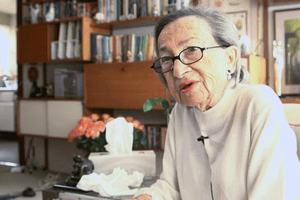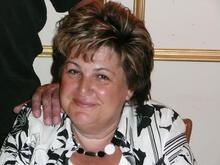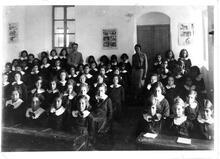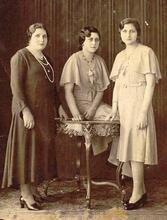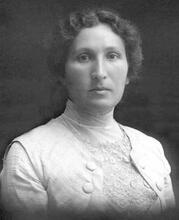Vele Rabinowitz Zabludowsky
Mexican Jewish educator Vele Zabludovsky, 2015. From the Yiddish Book Center's Wexler Oral History Project (https://www.yiddishbookcenter.org/collections/oral-histories/interviews/woh-fi-0000745/vele-zabludovsky-2015).
Vele Rabinowitz Zabludovsky's dedication to Yiddish language and its culture was a constant throughout her life. Born in Poland in 1923, she emigrated to New York 1935. In 1944, she traveled to Mexico, where she dedicated over fifty years to teaching Yiddish language and culture. She helped to form the Naye Yiddishe Schule (New Jewish School) in Mexico City. Exactly four months before Zabludovsky passed away on February 26, 2016, in an interview conducted in Mexico City with Christa Whitney of the Yiddish Book Center, Zabludovsky spoke of Yiddish with great hope and optimism for its future.
"Talking about Vele's history is talking about Naye Schule history. That tends to happen when a person creates something and then dedicates more than fifty years of their lives to an institution, especially in the way Vele did" (Strauch).
The Importance of Yiddishkayt
Vele Rabinowitz Zabludovsky has been characterized as a Yiddish and Hebrew teacher who worked with love, but above all as someone who taught her pupils what is called Yidishkayt as a profoundly Jewish part of life. Like the teacher Joseph Opotoushu (1886–1954), she asked herself, "Vos is Yidishkayt?" (What is Yidishkayt?), and answered, "Yidishkayt is altz und nokh epes" (Yidishkayt is everything and a little more). Yidishkayt formed part of her life as a whole. Remembering Vele Rabinowitz Zabludovsky, who served as a lererke (teacher) for more than fifty years, and remembering Naye Yiddishe Schule (New Jewish School) at which she worked are like remembering the same thing.
Exactly four months before Zabludovsky passed away on February 26, 2016, in an interview conducted in Mexico City with Christa Whitney of the Yiddish Book Center, she reflected on an interesting phenomenon: Younger generations have begun to take an interest in Yiddish. This phenomenon gave Zabludowsky great hope. Yet she pondered, why Yiddish? She reflected, "Perhaps it is that in Yiddish, they found a language without ceremony, without pretensions. A language full of tenderness and wisdom that opens a large window to great literature… Yiddish has not died. Why? Because as long as one person talks to another person or two people, I know it is not dead. That is what I hope. And I truly believe it will not die."
Zabludovsky's optimism and fight on behalf of the Yiddish language and its culture were constant at the schools where she worked and all the places she believed Yiddish had the potential to be taught. She dedicated her life to promoting Yiddish’s very existence: "To continue with Yiddish is not a nostalgic act or due to sentimentalism, but because it holds the rescue of a whole culture."
Early Life and Education
Zabludovsky was born in Bialystok, Poland, in 1923, the youngest of ten children of Harry Rabinowitz (1880–1962) and Mina Gimpelewich (1885–1967). The family was liberal and religious: at home, her mother had a Term used for ritually untainted food according to the laws of Kashrut (Jewish dietary laws).kosher kitchen, and the Jewish holidays were observed without any taint of fanaticism; her father was a carpenter and a shul yid (a Jew who went to the synagogue) whose fine voice led to his being a "baaltfile" (precentor). Bialystok was a city with vibrant Jewish political activity, political parties, and the modern school of Tzisho (Di Zentrale Yidishe Organizatzie). Rabinowitz's home was a living reflection of the discussions and antagonisms that prevailed in those days, given that her siblings were members of different parties: Communists, Zionists, Bundists, and apolitical.
In 1929 Zabludovsky’s father left Poland for the United States of America, and six years later, his wife and five daughters joined him. When Zabludovsky arrived in New York, she was eleven years old and was the only child in the family chosen by her parents to study.
At first, she spoke only Yiddish, her first language, with which she communicated in the Jewish neighborhood in Brooklyn, New York, where she lived. From grammar school until high school, she attended public school in the morning and a Jewish school in the afternoon. While studying at Thomas Jefferson High School from 1941 to 1943, she also attended night school at the Workmen's Circle Seminar. The Seminar had a socialist and secular tendency, similar to the Bundists. Bible and general subjects were taught in Yiddish, while Hebrew, with an Jews of European origin and their descendants, including most of North and South American Jewry.Ashkenazi pronunciation, held second place.
In 1944–1945 Zabludovsky traveled to Mexico to visit one of her sisters and met Samuel Zabludovsky (b. 1908), whom she married in New York in December 1945. The couple had no children. When Samuel died in 1971 at the age of sixty-one, he left a young widow. "In my pupils, I found the children I would have liked to have, from them I obtained love and satisfaction," Zabludovsky later reflected.
Teaching in Mexico
In 1947, Zabludovsky was invited to work in the Colegio Israelita de México (Jewish School of Mexico) kindergarten as a substitute teacher. In her new work environment she encountered ideological, personal, and community attacks against director Avraham Golomb, and teachers Yosef Rotemberg and Leib Bayon. Their advocacy of Yiddish, a belief in the need for retaining Jewish distinctiveness in the Diaspora, and the retention of Hebrew and Yiddish as the national languages of the Jewish people led to numerous conflicts with those who did not share their views. The thoughts and social positions of Golomb in particular caused tension among Zionists, Bundists, and Communists (Cimet). Golomb went so far in his anti-Zionism as to forbid Keren Kayemet (Jewish National Fund) collection boxes from being brought into the school on the grounds that “education should not have any taint of politics” (Starapolsky-Shwartz). Zabludovsky "chose to become more involved in working as a teacher than in the school's politics." Still, she decided to make common cause with the group that soon left to create a new school: Naye Yidisher Shule, which from the beginning was conceived as small, apolitical, and profoundly Yiddishist.
The rift in the Nuevo Colegio Israelita (Naye Yidisher Shule I. L. Peretz, 1950) proved a milestone in Zabludovsky’s activity as a Jewish education leader in Mexico. She decided to participate in the group that separated from the Colegio Israelita de Mexico (Yiddish School, 1924) in order to support Avraham Golomb (ca.1886–1982) and his wife Rivke Golomb (1905–1987) against the sudden ideological as well as personal attacks they suffered. The couple was also backed by some Bundist teachers, Zionists, and personal friends. "Lererke" Zabludovsky was motivated less by ideology than by a sense that the community's reactions and some teachers of the Colegio Israelita and its PTA were "unjust."
In 1959, when the school moved to more spacious quarters close to the CDI (Jewish Sports Center), the number of students grew, and Zabludovsky was promoted to serve as the kindergarten principal.
In 1972 Zabludovsky worked in both the kindergarten and the high school, where she taught Yiddish literature. In 1974 she was promoted to vice-principal of the school. In 1978 she was named the General Principal of the Nuevo Colegio Israelita, a post she held for fourteen years. When she left this position, she took a course in family therapy and counseling (1992–1995) and helped those who turned to the Kehillah (community) for aid. She returned to teaching the lererkes from the Yiddish School at the Seminar le-Morim (Teachers Seminar) of the Ashkenazi Kehillah for four years. She later taught the lererkes from the Naye Yidisher Shule on their premises.
In 1996 Zabludovsky returned to the Nuevo Colegio Israelita High School to teach Yiddish. She held Yiddish conversation groups, presided over the Pro-Yiddish Committee, and created the "Yiddish Musical Peña." In the Naye, she took on various roles as a founder, a choreographer, a teacher, a kindergarten principal, a member of the pedagogy and mothers committee, high school lererke, choir member, and general director.
Zabludovsky participated in congresses, round tables, and lectures at various institutions. Above all, she had a special gift of knowing people. She had a policy of always having her door open for anyone to enter to chat or discuss any problems. Besides being a teacher, she was a scholar and took several courses in France and Russia and pursued studies in Israel about Yiddish.
Legacy
In an interview with the Yiddish Book Center in Mexico City in October 2015, Talia Margolis Chomstein reflected on her experience as a student of Zabludovsky. Chomstein admired Zabludovsky’s work and reflected, “She is still understanding the relevance of Yiddish, even today. It is amazing how she is always looking for new things, new materials.” Chomstein had the opportunity to read Zabludovsky’s essays from her career and reflected: “I was amazed she was criticizing at that time the behavior of the community towards Yiddish…. She was so critical that I thought, this is still modern, this is still something we have to be sharing.” Students remember Zabludovsky as someone “who taught them to fight for education, equality, love, wisdom, knowledge, and language. Vele taught us to leave behind our fears and put words first” (Chomstein). In December 1999, the Mexico-Israel Cultural Institute awarded Zabludovsky a prize acknowledging her work in Mexico's Jewish Community.
Vele Rabinowitz Zabludovsky passed on Thursday, February 25, 2016, in Mexico City.
Ashkenazi de México, Kehila. “ ‘Flor y Canto: Las Voces De Los Poetas Yiddish Asesinados En La Unión Soviética’..” https://diariojudio.com/comunidad-judia-mexico/revive-el-evento-flor-y-canto-las-voces-de-los-poetas-yiddish-asesinados-en-la-union-sovietica-texto-de-vele-zabludovsky-velada-artistica/34109
Avni, Haim, ed. Testimonios de la Historia Oral. Judíos en México. UHJ y Amigos UHJ Mexico: 1990.
Chomstein, Talia Margolis. “Falleció La Lererke, Nuestra Lererke: Diario Judío México.” Diario Judío: Diario De La Vida Judía En México y El Mundo, 25 Feb. 2016, diariojudio.com/comunidad-judia-mexico/fallecio-la-lererke-nuestra-lererke/158974/.
Cimet de Singer, Adina. The Ashkenazi Jewish Community in Mexico: Ideologies in the Structuring of a Community. Albany, NY: State University of New York Press,: 1997.
Cimet, Adina. “Nacionalismo y Lengua: Los Judíos Ashkenazitas En México, 1940-1950.” Revista Mexicana de Sociología 58, no. 4 (1996): 69–96.
Finkelman de Sommer, Maty. Instruye a tus hijos. In Generaciones judías en México. Kehila Ashkenazi (1922–1992). Alice G. Backal (Coord.). Mexico: Comunidad Ashkenazí de México, 1993.
Strauch, Morris. “La Historia De Vele Zabludovsky Z‘L Es La Historia De La Naye.” Enlace Judío, February 26, 2016. https://www.enlacejudio.com/2016/02/25/la-historia-de-vele-zabludovsky-zl-es-la-historia-de-la-naye/.
Whitney, Christa. “A Window to a World: Thoughts on Why Young People Come to Yiddish.” The Yiddish Book Center's Wexler Oral History Project, October 26, 2015. https://www.yiddishbookcenter.org/collections/oral-histories/excerpts/woh-ex-0004148/window-world-thoughts-why-young-people-come-yiddish.
Whitney, Christa. “Talia Margolis Chomstein's Oral History.” The Yiddish Book Center's Wexler Oral History Project, October 29, 2015. https://www.yiddishbookcenter.org/collections/oral-histories/interviews/woh-fi-0000743/talia-margolis-chomstein-2015?segment=4425.
Zabludowsky, Vele. Interview with Naty G. de Okon, August 1988. Ivgn Testimonios de la Historia Oral. Judíos en México Avni, Haim, editor. México: 1990.
Zabludowsky, Vele. Interview with Frida Staropolsky. February 2 and August 27, 2002.

